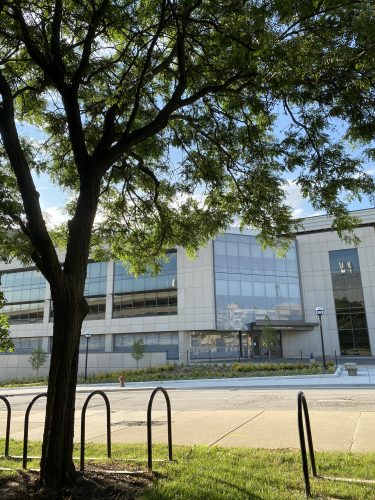
The trunks on most trees can look fairly similar. But the leaves on the branches can look quite different (like our curriculum)! Photo taken outside Taubman Health Sciences Library.
“Just wait until you get to the Branches!” I had heard some variation of this statement throughout my first two years of medical school whenever conversations about curricular flexibility came up. After finishing clerkship year and USMLE Step 1, my class entered into the “Branches” of the curriculum. As a brief primer, the University of Michigan Medical School divides the curriculum into two parts, the “Trunk” and the “Branches”. The Trunk is broken up into the pre-clinical and clinical trunks, which encompass the first two years of medical school at the University of Michigan. The Branches, the third and fourth years of medical school, is the 17-18-month period leading up to graduation that offers the freedom to explore future career choices and develop personal interests.
Admittedly, when I first heard about the Branches when I was as a pre-clinical “Trunk” student, the concept felt elusive, as our house counselors had told us that our experience would be what we chose to make of it. At baseline, we choose one of four possible Branch pathways, each offering a specific focus into patient care (Patients and Populations, Procedure-Based Care, Diagnostics and Therapeutics, or Systems and Hospital-Based Care) and establish relationships with advisors, both in our Branch and in our future specialty of choice (faculty career advisors). As part of our graduation requirements, we also must complete several rotations during the Branches, including at least four graded clinical electives, an ICU rotation, a sub-internship, and an EM rotation with protected time for residency interviews, a residency prep course, and vacation.
What I hadn’t realized as an M1 student was that as Branches students we would have a broad spectrum and diversity of opportunities at our fingertips, as long as we wanted to pursue them. We are encouraged to explore fields and interests that we may have a low likelihood of experiencing through residency that can help deepen previous interests or layer other interests to diversify and offer breadth to our personal studies. There are clinical electives from across 20+ departments — see a taste of what’s available below. Other more niche elective options include Wilderness Medicine, Comparative Medicine, Street Medicine, Disability Health, Visual Arts in Medicine, Medical Communication through Wikipedia, and more.
- Consult Service (Adult or Pediatric, 20+ services including cardiology, infectious diseases, and allergy)
- Anesthesia electives (Adult or Pediatric)
- Clinical Ethics Service
- Family Medicine in Japan
- Sleep Medicine
- Reproductive Endocrinology and Infertility
- Forensic Psychiatry
- Addiction Treatment Services
- Nuclear Medicine
- Interventional Radiology
- And…
The Branches offer significant time before working on residency applications to define and solidify future planning as well. For those who remain uncertain about their eventual field of choice, the Branches offer two week “exploratory” electives for students to learn more about fields that they hadn’t had previous exposure to, such as radiation oncology, dermatology, physical medicine and rehabilitation, anesthesiology, and sub-specialty surgical fields (orthopedics, ophthalmology, plastics, otolaryngology, neurosurgery, etc.). These electives are different from sub-internships (sub-Is), which are clinical rotations where the medical student is given the responsibilities and expectations to perform at the level of a first-year resident. A sub-I can be done on a variety of different services in a multitude of specialties.
There are many opportunities for creativity in the Branches as well. If a particular elective doesn’t exist, you can create your own individually arranged clinical elective (or INDARR as we affectionately call it). I have had peers create self-driven courses with topics such as cardiac electrophysiology, the intersection of transplant medicine and surgery, and narrative medicine (complete with a book reading list!). We can dedicate time and resources to work on research and our Capstone for Impact projects, our passion project intended to create a positive impact within health care. If there is a faculty physician we want to clinically learn from, we can arrange a longitudinal apprenticeship in which the student will go to the attending’s clinic on a weekly basis. During the months leading up to ERAS submission, some students will schedule clinical rotations at a different institution (“away rotations”) with the aim of experiencing a different institutional culture or eventually ending up there for residency.
As one example of the thousands of available permutations, my Branches schedule (listed below) has been focused on developing the perspective and skills to be a good general surgeon as well as revisiting my previous experience in health care finance and administration. However, this course I’ve charted for myself looks starkly different from my friend’s path (listed below mine), who is deciding between internal medicine and emergency medicine, with the final goal of critical care. If it’s not already obvious, some of the difficulty of broadly advising for the Branches is that your path forward is truly based on your own personal interests and future aspirations.

“Flight Paths” by Steve Waldeck, a 450-foot multisensory walk through a simulated Georgia forest, with a sculptural tree canopy that filters layers of light, surrounded by sounds and animation of local wildlife. Photo taken at Atlanta International Airport on my way home from Academic Surgical Congress (February, 2020).
My Branches path:
- Strategic Management for Physicians
- Anesthesia Clinical Elective
- Sub-I in Endocrine and Minimally Invasive Surgeries
- Surgical ICU Rotation
- Palliative Care Elective
- “Problem-Based Scientific Inquiry” (PBSI) Course
- Online Opioids Elective
- Research Elective
My friend’s Branches path:
- Anesthesia Clinical Elective
- Online Pediatric Injury Prevention Course
- Orthopedic Surgery Consult
- Medicine ICU rotation at St. Joe’s
- Emergency Medicine (EM) Rotation
- Sub-I in the IM Hospitalist Service
- EM away rotation at Henry Ford
- Apprenticeship with a pulmonary critical care physician
As my class enters the residency application season, the Branches have offered a wonderful period to prepare and propel us towards defining the careers we envision. We have the ability to draft the narrative we want as long as we’re willing to imagine it.
You can find more information about the Branches here.
Don’t miss the next Dose of Reality.
Lucy Zhuo is from Chicago, IL and is a rising fourth year medical student at the University of Michigan Medical School. She is passionate about surgical culture and education. She loves hanging out with her roommate’s cat, tinkering with art projects, and searching for new favorite coffee shops. She will be applying into General Surgery for residency this coming fall. She can be followed on Twitter @lzhuo22.
